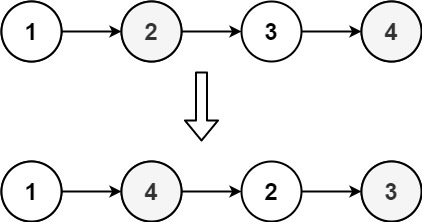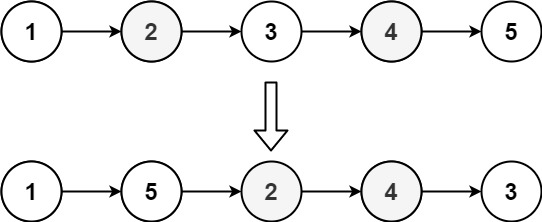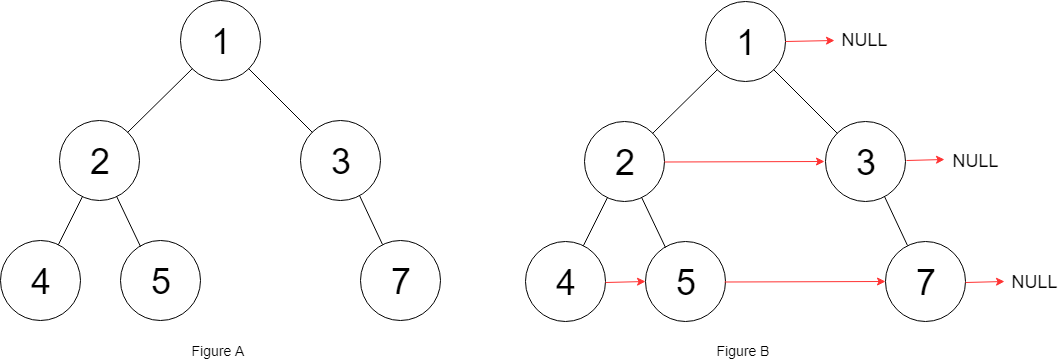Java每日一练(20230328)
JAVA 每日
2023-09-14 09:01:29 时间

目录
1. 四数之和 🌟🌟
2. 重排链表 🌟🌟
1. 四数之和
给定一个包含 n 个整数的数组 nums 和一个目标值 target,判断 nums 中是否存在四个元素 a,b,c 和 d ,使得 a + b + c + d 的值与 target 相等?找出所有满足条件且不重复的四元组。
注意:答案中不可以包含重复的四元组。
示例 1:
输入:nums = [1,0,-1,0,-2,2], target = 0 输出:[[-2,-1,1,2],[-2,0,0,2],[-1,0,0,1]]
示例 2:
输入:nums = [], target = 0 输出:[]
提示:
0 <= nums.length <= 200-10^9 <= nums[i] <= 10^9-10^9 <= target <= 10^9
出处:
https://edu.csdn.net/practice/23951361
代码: 暴力枚举
class Solution {
public List<List<Integer>> fourSum(int[] nums, int target) {
long l_target = target;
Arrays.sort(nums);
List<List<Integer>> results = new ArrayList<>();
int N = nums.length;
for (int i = 0; i < N - 3; i++) {
if (i > 0 && nums[i] == nums[i - 1]) // 跳过相等的元素
continue;
for (int j = i + 1; j < N - 2; j++) {
if (j > i + 1 && nums[j] == nums[j - 1]) // 跳过相等的元素
continue;
for (int k = j + 1, l = N - 1; k < l; k++) {
if (k > j + 1 && nums[k] == nums[k - 1]) // 跳过相等的元素
continue;
while (k < l && (l_target - nums[i] - nums[j] - nums[k] - nums[l]) < 0) {
l--;
}
if (k >= l) {
break;
}
if ((target - nums[i] - nums[j] - nums[k] - nums[l]) == 0) {
List<Integer> item = new ArrayList<>();
item.add(nums[i]);
item.add(nums[j]);
item.add(nums[k]);
item.add(nums[l]);
results.add(item);
}
}
}
}
return results;
}
}代码2: 双指针
class Solution {
public List<List<Integer>> fourSum(int[] nums, int target) {
List<List<Integer>> res = new ArrayList<>();
int n = nums.length;
if (n < 4) {
return res;
}
Arrays.sort(nums);
for (int i = 0; i < n - 3; i++) {
// 如果当前数字与前一个数字相同,会导致重复,跳过
if (i > 0 && nums[i] == nums[i - 1]) {
continue;
}
// 剪枝,如果当前数字加上剩下三个数字的最小和都大于目标值,就没必要继续了
if (nums[i] + nums[i + 1] + nums[i + 2] + nums[i + 3] > target) {
break;
}
// 剪枝,如果当前数字加上剩下三个数字的最大和都小于目标值,就没必要继续了
if (nums[i] + nums[n - 1] + nums[n - 2] + nums[n - 3] < target) {
continue;
}
for (int j = i + 1; j < n - 2; j++) {
// 如果当前数字与前一个数字相同,会导致重复,跳过
if (j > i + 1 && nums[j] == nums[j - 1]) {
continue;
}
// 剪枝,如果当前数字加上剩下两个数字的最小和都大于目标值,就没必要继续了
if (nums[i] + nums[j] + nums[j + 1] + nums[j + 2] > target) {
break;
}
// 剪枝,如果当前数字加上剩下两个数字的最大和都小于目标值,就没必要继续了
if (nums[i] + nums[j] + nums[n - 1] + nums[n - 2] < target) {
continue;
}
int left = j + 1;
int right = n - 1;
while (left < right) {
int sum = nums[i] + nums[j] + nums[left] + nums[right];
if (sum < target) {
left++;
} else if (sum > target) {
right--;
} else {
res.add(Arrays.asList(nums[i], nums[j], nums[left], nums[right]));
// 如果左指针和右指针指向的数字与它们前面的数字相同,会导致重复,跳过
while (left < right && nums[left] == nums[left + 1]) {
left++;
}
while (left < right && nums[right] == nums[right - 1]) {
right--;
}
left++;
right--;
}
}
}
}
return res;
}
}代码3: 哈希表
class Solution {
public List<List<Integer>> fourSum(int[] nums, int target) {
List<List<Integer>> res = new ArrayList<>();
int n = nums.length;
Arrays.sort(nums); // 排序
Map<Integer, List<int[]>> map = new HashMap<>(); // 哈希表
for (int i = 0; i < n-1; i++) {
for (int j = i+1; j < n; j++) {
if (!map.containsKey(nums[i]+nums[j])) { // 如果不存在,创建一个新的列表
map.put(nums[i]+nums[j], new ArrayList<>());
}
map.get(nums[i]+nums[j]).add(new int[]{i, j}); // 将下标加入到列表中
}
}
for (int i = 0; i < n-1; i++) {
if (i > 0 && nums[i] == nums[i-1]) continue; // 跳过相等的元素
for (int j = i+1; j < n; j++) {
if (j > i+1 && nums[j] == nums[j-1]) continue; // 跳过相等的元素
if (map.containsKey(target-nums[i]-nums[j])) { // 如果存在,将所有满足条件的四元组加入到结果中
List<int[]> temp = map.get(target-nums[i]-nums[j]);
for (int[] t : temp) {
if (t[0] > j) { // 确保四元组不重复
List<Integer> quadruplet = new ArrayList<>();
quadruplet.add(nums[i]);
quadruplet.add(nums[j]);
quadruplet.add(nums[t[0]]);
quadruplet.add(nums[t[1]]);
res.add(quadruplet);
}
}
}
}
}
return res;
}
}2. 重排链表
给定一个单链表 L 的头节点 head ,单链表 L 表示为:
L0 → L1 → … → Ln-1 → Ln
请将其重新排列后变为:
L0 → Ln → L1 → Ln-1 → L2 → Ln-2 → …
不能只是单纯的改变节点内部的值,而是需要实际的进行节点交换。
示例 1:

输入: head = [1,2,3,4] 输出: [1,4,2,3]
示例 2:

输入: head = [1,2,3,4,5] 输出: [1,5,2,4,3]
提示:
- 链表的长度范围为
[1, 5 * 10^4] 1 <= node.val <= 1000
出处:
https://edu.csdn.net/practice/23951362
代码:
public class ListNode {
int val;
ListNode next;
ListNode(int x) {
val = x;
}
}
class Solution {
public void reorderList(ListNode head) {
if (head == null) {
return;
}
ListNode fast = head, slow = head;
while (fast != null && fast.next != null) {
fast = fast.next.next;
slow = slow.next;
}
ListNode cur = slow.next, pre = null, next = null;
slow.next = null;
while (cur != null) {
next = cur.next;
cur.next = pre;
pre = cur;
cur = next;
}
ListNode p1 = head, p2 = pre;
while (p1 != null && p2 != null) {
next = p2.next;
p2.next = p1.next;
p1.next = p2;
p1 = p2.next;
p2 = next;
}
}
}代码2:
public void reorderList(ListNode head) {
if (head == null || head.next == null) {
return;
}
List<ListNode> nodeList = new ArrayList<>();
ListNode node = head;
while (node != null) {
nodeList.add(node);
node = node.next;
}
int left = 0, right = nodeList.size() - 1;
while (left < right) {
nodeList.get(left).next = nodeList.get(right);
left++;
if (left == right) {
break;
}
nodeList.get(right).next = nodeList.get(left);
right--;
}
nodeList.get(left).next = null;
}3. 填充每个节点的下一个右侧节点指针 II
给定一个二叉树
struct Node {
int val;
Node *left;
Node *right;
Node *next;
}
填充它的每个 next 指针,让这个指针指向其下一个右侧节点。如果找不到下一个右侧节点,则将 next 指针设置为 NULL。
初始状态下,所有 next 指针都被设置为 NULL。
进阶:
- 你只能使用常量级额外空间。
- 使用递归解题也符合要求,本题中递归程序占用的栈空间不算做额外的空间复杂度。
示例:

输入:root = [1,2,3,4,5,null,7] 输出:[1,#,2,3,#,4,5,7,#] 解释:给定二叉树如图 A 所示,你的函数应该填充它的每个 next 指针,以指向其下一个右侧节点,如图 B 所示。序列化输出按层序遍历顺序(由 next 指针连接),'#' 表示每层的末尾。
提示:
- 树中的节点数小于
6000 -100 <= node.val <= 100
出处:
https://edu.csdn.net/practice/23951363
代码:
class Node {
public int val;
public Node left;
public Node right;
public Node next;
public Node() {
}
public Node(int _val) {
val = _val;
}
public Node(int _val, Node _left, Node _right, Node _next) {
val = _val;
left = _left;
right = _right;
next = _next;
}
};
class Solution {
public Node connect(Node root) {
if (root == null || (root.left == null && root.right == null)) {
return root;
}
if (root.left != null && root.right != null) {
root.left.next = root.right;
root.next = getrightnext(root);
}
if (root.left != null) {
root.left.next = getrightnext(root);
}
if (root.right != null) {
root.right.next = getrightnext(root);
}
connect(root.right);
connect(root.left);
return root;
}
public static Node getrightnext(Node root) {
while (root.next != null) {
if (root.left != null) {
return root.left;
}
if (root.right != null) {
return root.right;
}
root = root.next;
}
return null;
}
}
🌟 每日一练刷题专栏 🌟
✨ 持续,努力奋斗做强刷题搬运工!
👍 点赞,你的认可是我坚持的动力!
🌟 收藏,你的青睐是我努力的方向!
✎ 评论,你的意见是我进步的财富!
☸ 主页:https://hannyang.blog.csdn.net/
 | Golang每日一练 专栏 |
 | Python每日一练 专栏 |
 | C/C++每日一练 专栏 |
 | Java每日一练 专栏 |
相关文章
- HBase(2) Java 操作 HBase 教程
- java:安装tomcat8/tomcat9(简单安装配置)
- Java实现 LeetCode 822 翻转卡片游戏(暴力)
- Java实现 LeetCode 739 每日温度(暴力循环)
- Java实现 LeetCode 739 每日温度(暴力循环)
- Java实现 蓝桥杯 算法提高 矩形靶
- java实现 洛谷 P1017 进制转换
- java实现输入日期
- java实现取字母组成串
- java实现填写算式
- Java实现 蓝桥杯VIP 算法训练 最大值与最小值的计算
- Java实现 蓝桥杯 算法训练 未名湖边的烦恼
- (Java实现) 洛谷 P1781 宇宙总统
- java对象创建过程(jvm)
- Java每日一练(20230419)
- Java每日一练(20230418)
- Java每日一练(20230415)
- Java每日一练(20230411)
- Java每日一练(20230401)
- Java每日一练(20230331)
- Java每日一练(20230327)
- Java每日一练(20230323)
- Java每日一练(20230314)
- Java每日一练(20230312)
- 自定义Java annotation及解析和使用
- 还在手动发早安吗?教你用java实现每日给女友微信发送早安
- java 枚举(enum) 全面解读
- java===java基础学习(12)---方法的重写和重载
- Java与WCF交互(一):Java客户端调用WCF服务
- 基于Java+SpringBoot+Vue+uniapp前后端分离图书阅读系统设计与实现
- 单链表(Java每日一题)
- 排列数字(Java每日一题)
- 0基础入行Java开发—详解Java泛型之详解通配符

